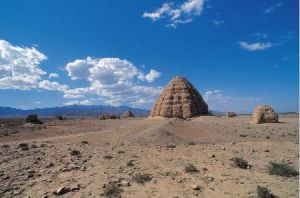Western Xia Tombs
On a vast expanse of desert at the foot of Helan Mountains stand a group of tower-like earthen platforms, which have been identified as a burial ground, with at least nine royal tombs and over 250 subordinate tombs of the Western Xia Dynasty, a regime that ruled the Ningxia-Gansu area concurrent to the rule by Song court of the China Central Plains. They are known as “ Pyramids in the East.”
The nine royal tombs are arranged in two rows, with each forming a complete architectural complex. Lying in the chamber of each royal tomb were images of warriors and other exquisite paintings, crafts, bricks and clay articles. All the square bricks used to built the tomb chamber were engraved with square characters and motifs.
The structures of the tombs not only show features of tombs the Tang and Song dynasties but also those of Buddhist structures, representing a combination of the cultures of the Han people, Buddhism and the Dangxiang (an ancient tribe that established the Western Xia regime). Magnificent in scale, each of the royal tomb occupies over 100,000 sq. m in area, compriving archways, watchtowers, pavilions, outer and inner walls, a memorial hall, an altar and other structures.
The No. 3 tomb is the best preserved and the largest of the nine, covering 150,000 sq. Archeologists have determined it to be the tomb of Li Yuanhao, founder of the Western Xia Dynasty.
